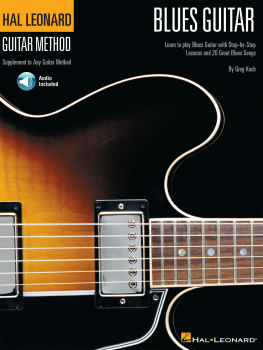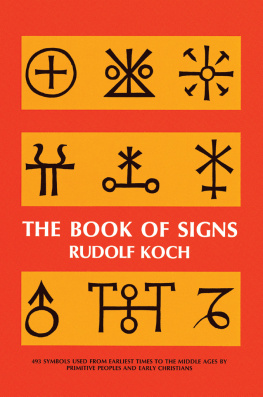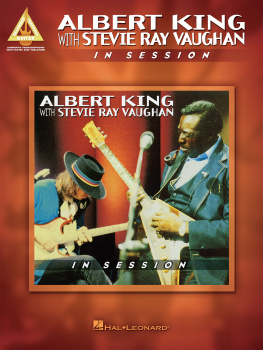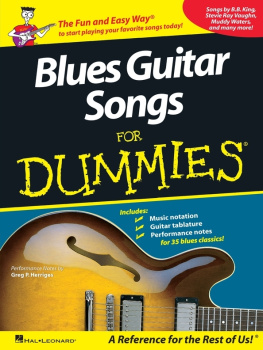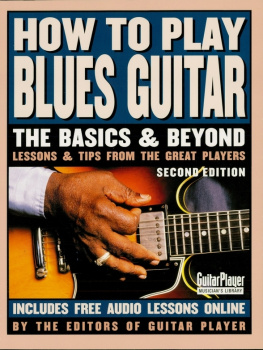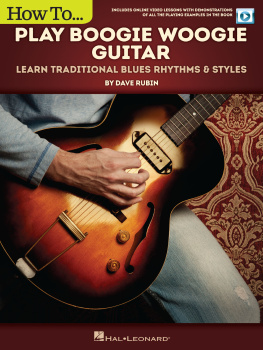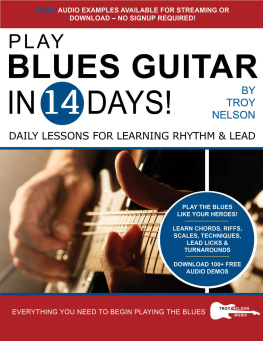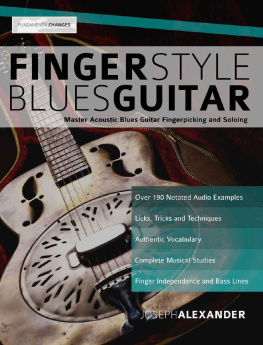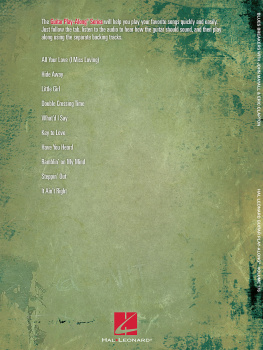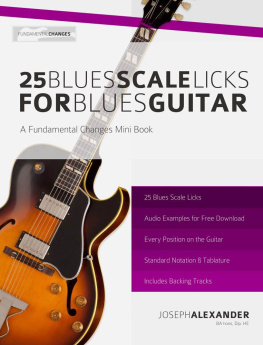Gibson ES-175 (left), Gibson ES-335 (right) and tweed 4x10 Fender Bassman combo amp
This book was written with the electric guitar in mind, but if armed with only an acoustic, you will still be able to work your way through most of the examples, especially if you use an unwound G string for easier bending. Its a good idea to take a minute to address what kind of electric guitars and amplifiers are the most blues friendly.
In choosing an electric guitar to best facilitate playing the blues, you may want to consider what artists you admire and what they use to get their tone. There are differing schools of thought on guitar tone, and that does reflect in how one approaches the instrument. For instance, the beefy tone of humbucker pickups found on such guitars as the Gibson ES-335, Les Paul, Flying V, and SG, the Guild Starfire and Bluesbird, among others, are distinctive in the more singing, lead accompaniment styles of artists such as B.B., Albert, and Freddie King; whereas the glassy, brighter tone of single-coil pickups found in Fender Stratocasters, Telecasters, and Danelectro guitars, among others, are key in the more rhythmic, biting styles of players such as Muddy Waters, Buddy Guy, and Stevie Ray Vaughan. The actual playability of these instruments is as much a matter of taste as the tone. I suggest testing out a variety of guitars and find something you are comfortable with as well as one you look forward to playing.

Fender Stratocasters and 4x12 Marshall stack
As for amplification, youll find a warm, meaty, articulate tone using an old Fender, Gibson, or National tube amp. These were the chosen tone consoles for many of the blues greats. More contemporary blues artists who may demand more distortion might lean towards modern Fender, Marshall, MESA, Sunn, or any variety of high-gain amps. Although solid-state technology was panned for years as being sterile and harsh, a number of manufacturers have come up with some pretty believable and affordable models. Again, I would consider the tones of some of your favorite artists: Stevie Ray Vaughan used Fender Super Reverbs predominately, B.B. King opted for the Fender Twin, John Mayall- and Cream-era Eric Clapton preferred Marshalls. In the end, whatever makes sense to you in terms of sound, size, and price is good to go!
PICK VS. FINGERS
One of the many great things about playing blues guitar is that there are no rules. Many a great bluesman, from Albert King to Albert Collins, have forsaken the plectrum in favor of flesh on string. I tend to steer people toward experimenting with both so that you can get the best of both worlds. How you attack the strings can make a huge difference in the sound, and ultimately, the way you express yourself. A pick is going to give you a brighter, more aggressive sound, and a fingerstyle attack gives a mellower touch that can be made more aggressive by popping the strings. Again, experiment with both!
STANDING VS. SITTING
Another habit that I encourage in order to prepare for eventually performing out in public or with friends is that you stand when you practice. This doesnt mean you need to stand every time you grab the guitar, but once youve got a new lick or technique under your fingers, put a strap on and get used to playing it while standing. The way you distribute your weight, how you approach the guitar, and the difference in how you support the instrument will all make a big difference in how well you play when standing versus sitting.
And while youre at it, plug in. In the the same way that the difference between sitting and standing can be night and day, practicing unplugged with an electric guitar can make for an eye-opening experience when you finally do get powered up. How you dampen strings, dynamics, and overall tone can be grossly misjudged if not amplified, so be sure you spend enough time plugged in if youre playing an electric guitar.
HAND POSITIONING

Thumb positioning for playing blues
When you see blues guitarists in action, youll notice that their thumbs are often wrapped around the neck as opposed to the more traditional grip, which has the thumb located on the back of the neck to facilitate a piston-like action by your fingers on the fretboard. The reason for this is that it gives you extra leverage for bending notes. It is important, however, to be able to go back and forth between these hand positions as your technique develops, but for the purposes of this book, it will be easier to do the bending exercises with the thumb over the neck hand positioning.
THE 12-BAR BLUES
The blues is a musical form as much as it is a musical style or feeling. The most common blues form is the 12-bar blues consisting of the IIVV progression. And the language can be further embellished with terms such as dominant seventh chord, quick change, or turnaround. As you might have guessed, most of these terms have their roots in music theory, though they should not send the would-be blues enthusiast into pangs of terror. Ill try to make it simple so as not to give you the blues!
The progression below is a blues in the key of G. It consists of twelve measures, or bars, and the chords within this blues form are the I (G7), IV (C7), and V (D7) chords in the key of G. This would be an example of a quick change, because after the first bar of the I chord (G7), the harmony shifts immediately to the IV chord (C7). The last two bars are known as the turnaround because chordally, it turns you around to the I chord at the top of the progression.

